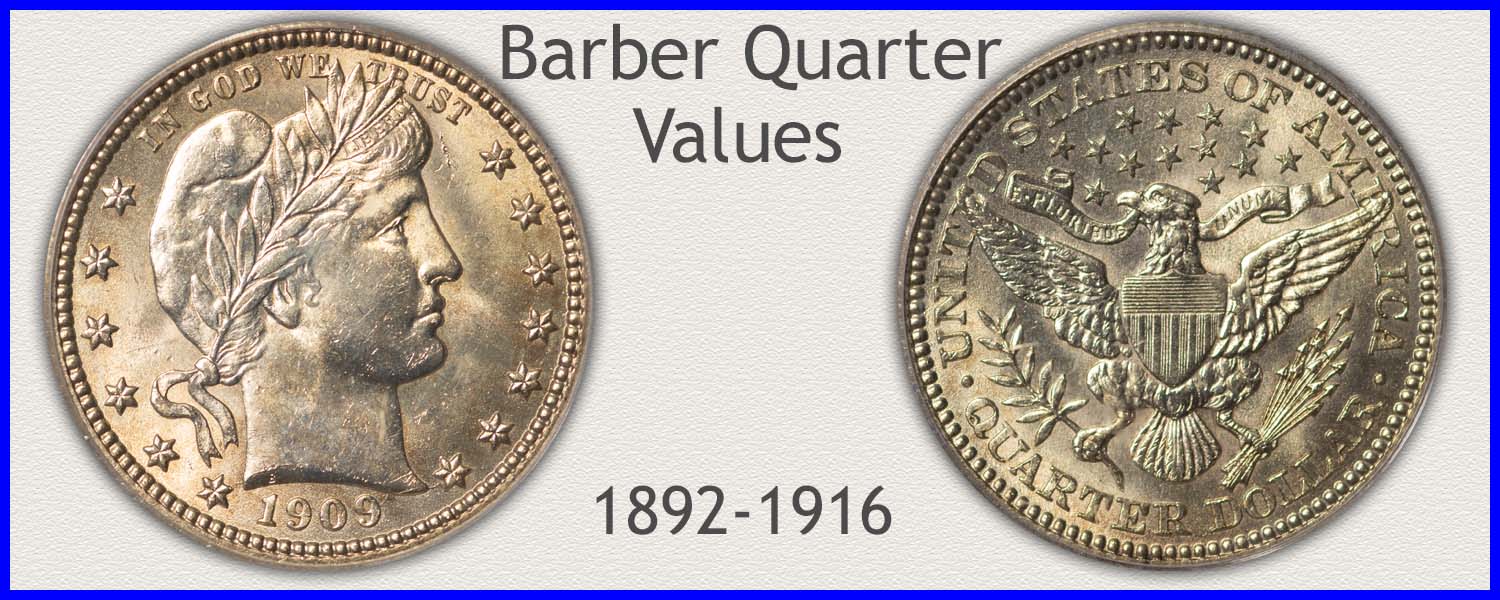Coin Values Moving with Precious Metals: Up-Dated 4/14/2025: Gold $3226 | Silver $31.88
1901 Quarter Value
1901 quarter value can vary greatly. They are currently worth a minimum of $7.69 each.
In order to determine the coin's worth accurately, it is necessary to confirm the specific mint variety. Collectors are especially interested in the San Francisco issue quarter, a difficult coin to find in all conditions. Close inspection is made to identify the mint variety, which is followed by evaluating condition.
Proceeding through a defined step-by-step process confirms how much these Barber quarters are worth.
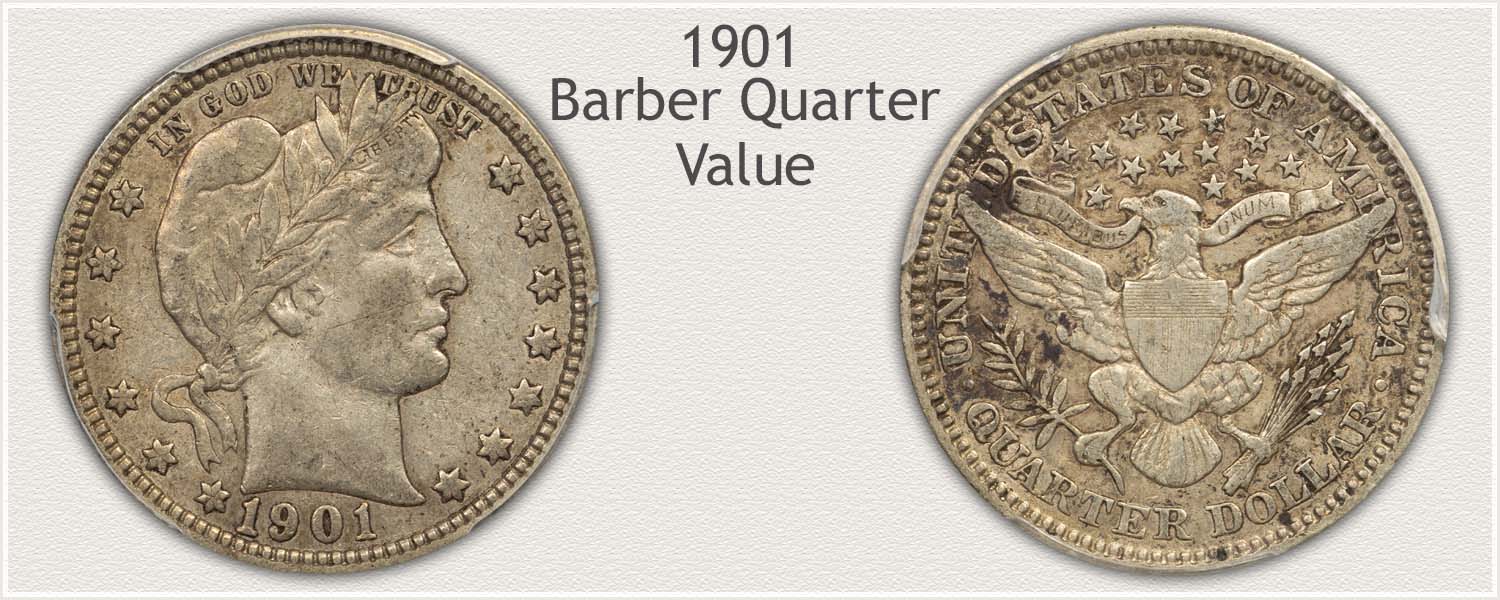
Steps Leading to Value:
- Step 1: Date and Mintmark Variety - Value of a 1901 quarter varies greatly depending on the mint variety. There is an active collector market for the different mint issues and dates.
- Step 2: Grading Condition - A coin's condition is an important factor in determining its value. Grades are assigned to each coin to determine its position on the chart.
- Step 3: Special Qualities - The key varieties of the year are identified and explored in detail.
| 1901 Quarter Value | ||||
|---|---|---|---|---|
| Condition of Coin | ||||
| Date | Good | Fine | Extremely Fine | Mint State |
| Barber Quarter Values Updated | 4/14/2025 | |||
| 1901 | $7.69 | $25 | $61 | $203 |
| 1901 O | $44 | $167 | $497 | Rare |
| 1901 S | $2,576 | Rare | Rare | Rare |
Listed are a range of wholesale value for conservatively graded Barber quarters. Use the steps to grading to help narrow the ranges found on the chart.
Step 1: | Identify the Important Date and Mintmark Combinations
1901 Branch Mint Rarities Recognized
1901 is noted by collectors as the year of the rare San Francisco mint quarter. Also important is the New Orleans quarter, another elusive coin to find today. The use of mintmarks by the mints identifies their production and the listing on the chart show the wide range in values.
Each different mintmark is imaged, examine the coin closely, a small mintmark becomes an important factor in an accurate description.
1901-S Barber Quarter
"S" Mintmark on Reverse: San Francisco Mint Struck the Coin
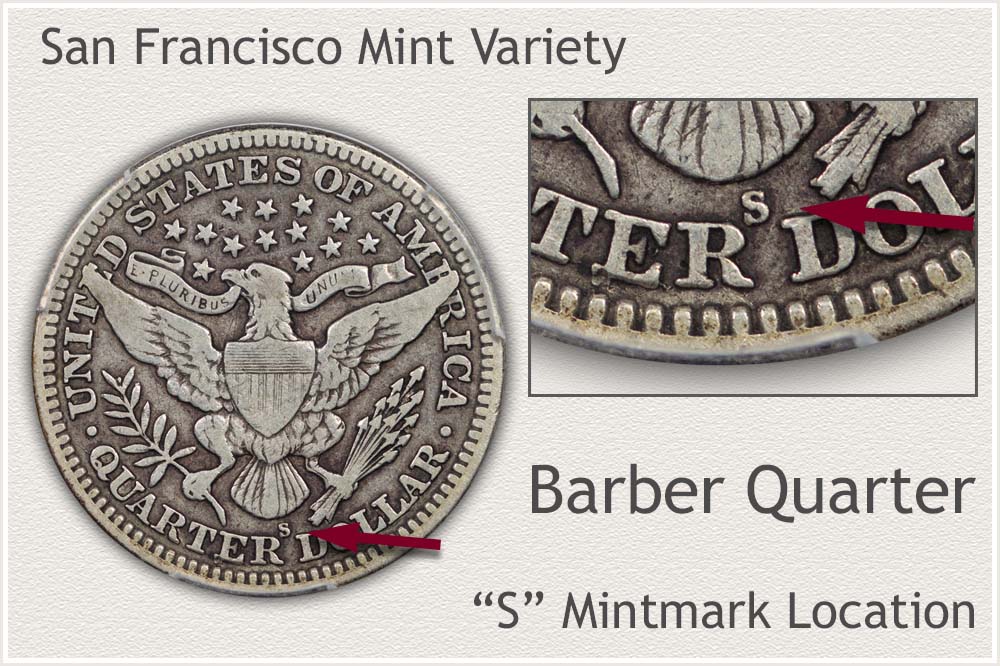
Demand from collectors and dealers has placed a very strong value on the 1901 San Francisco quarter. With just 72,644 struck, combined with few remaining today, this mint variety 1901 quarter is the highest valued coin of the Barber quarter series.
All are inspected very closely to both judge condition and confirm the date and mint combination. With such a high premium, condition plays a strong role in the final evaluation. Consider having any 1901-S quarter evaluated by one of the top two grading and authenticating services. This page; Coin Grading Services gives an introduction to the process. Additionally, contacting one of the authorized dealers listed on the grading service sites is an option.
To confirm the San Francisco mint variety. Look on the reverse of the coin, above the letters "R" and "D" of "Quarter Dollar" a large "S" is the mintmark of San Francisco.
1901-O Barber Quarter
"O" Mintmark on Reverse: New Orleans Mint Struck the Coin
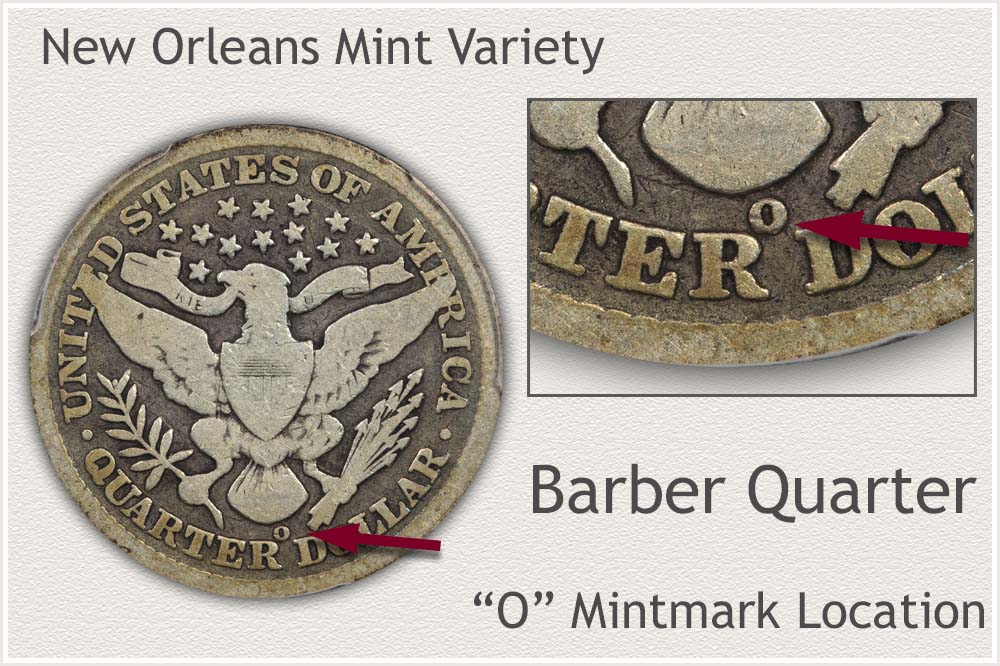
Collectors are particularly interested in the quarters produced in New Orleans in 1901. They face a challenge in finding attractive, pleasing specimens to add to collections. Just a little more than 1.6 million were struck at the New Orleans mint, enough to meet demands of trade at the time. This is only slightly less than the mint's usual annual output. However, these are now a popular mint variety appealing to many collectors, leading to a high demand. Date and mint set collectors, as well as those interested in New Orleans issues, are seeking these vintage quarters.
A mintmark "O" appears on the reverse of all New Orleans mint issues. A large "O" is placed above the words "Quarter Dollar" as seen on this example. The mint variety and date of a scarce coin are verified by the "O" mintmark.
1901 Barber Quarter
No Mintmark on Reverse: Philadelphia Mint Struck the Coin
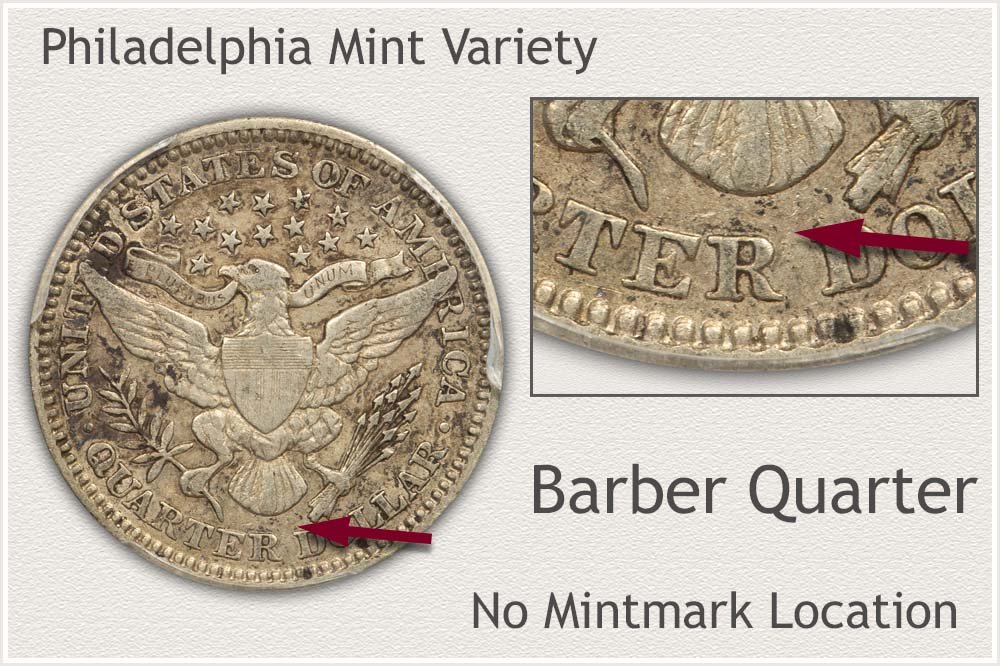
Philadelphia quarters are often chosen by collectors looking for a nice representative issue of 1901. Because of availability and affordability, it is a popular mint variety. In contrast to the two scarce branch mint varieties of 1901, it was produced in a much larger quantity; 8.8 million pieces were struck.
Silver investors and coin collectors are the two primary markets for these vintage Barber quarters. Value of heavily worn examples is relatively close to their silver content. A collector wants to find a type of coin that has less wear and displays many details.
Coins struck at branch mints are recognized by their distinctive mintmarks, whereas those struck at the Philadelphia mint are identified by the lack of mintmarks. Turning the coin to the reverse, examine the area directly above "Quarter Dollar." If the space is empty, the quarter is from the Philadelphia mint.
Step 2: | Grading Defines a High Level of Accuracy to Condition
Identify 1901 Quarter Value by its Grade
There are recognizable stages in the amount of wear on coins. Wear causes distinct changes to the remaining design as high points of the design are flattened. Different grades are distinguished by these visual changes.
When you start with a coin that is in mint condition, you can see every feature it had when it was initially struck. Grade each coin based on matching to an image showing a similar condition.
Mint State Grade
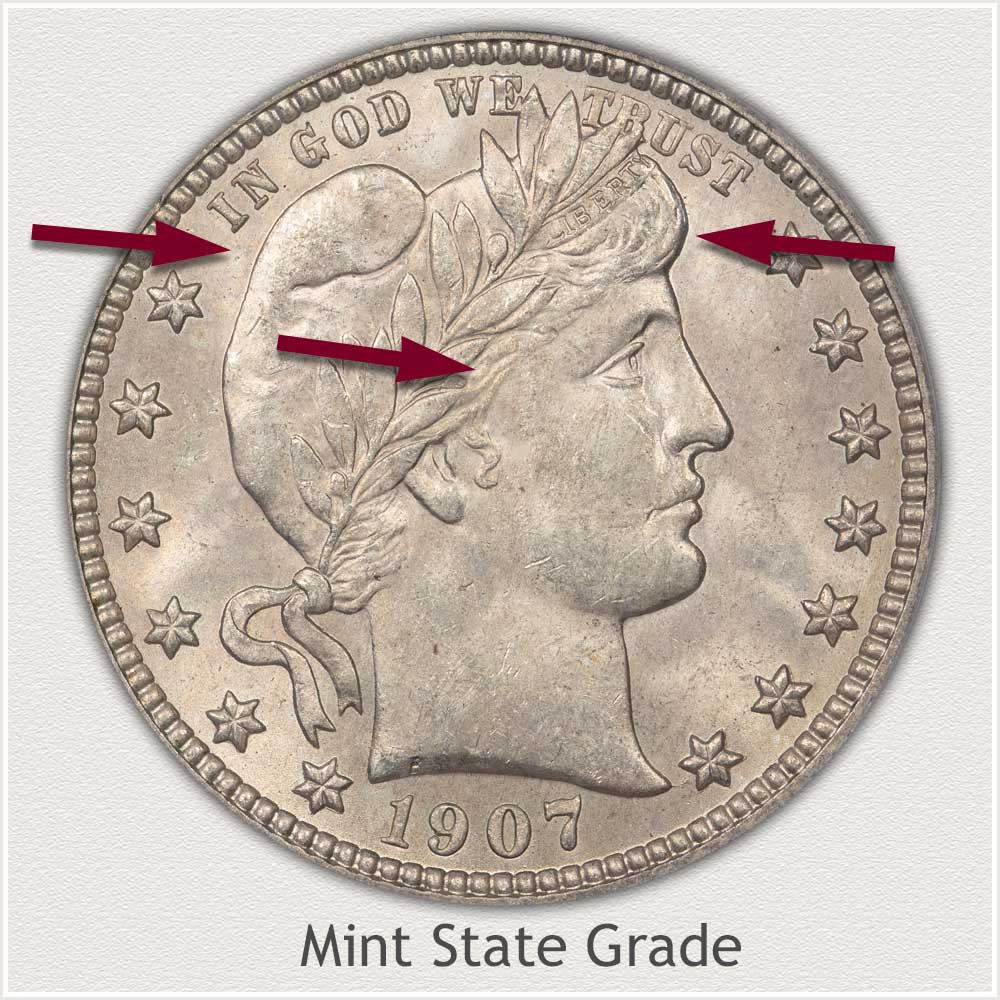
Mint State: A quarter is considered an example in Mint State grade if the surface has not been worn. These quarters display a brilliance when they are first minted due to the surface texture of fine grain lines. When the coin is turned and tilted under a light, this texture produces a flowing luster effect.
High areas of the design are inspected for signs of wear. An absence of smoothing, dulling, and flattening is noted to confirm that this delicate luster is complete. During circulation, the cap of Liberty quickly dulls and becomes smooth. Inspecting the upper edge of the cap, luster remains; no metal wear has occurred. In contrast to the brightness of an original minted surface, worn silver takes on a soft gray tone.
Also, visible above Liberty's forehead are fine lines in her hair. This area of very high relief receives the most wear, with the example quarter displaying no flattening of the design.
Extremely Fine Grade
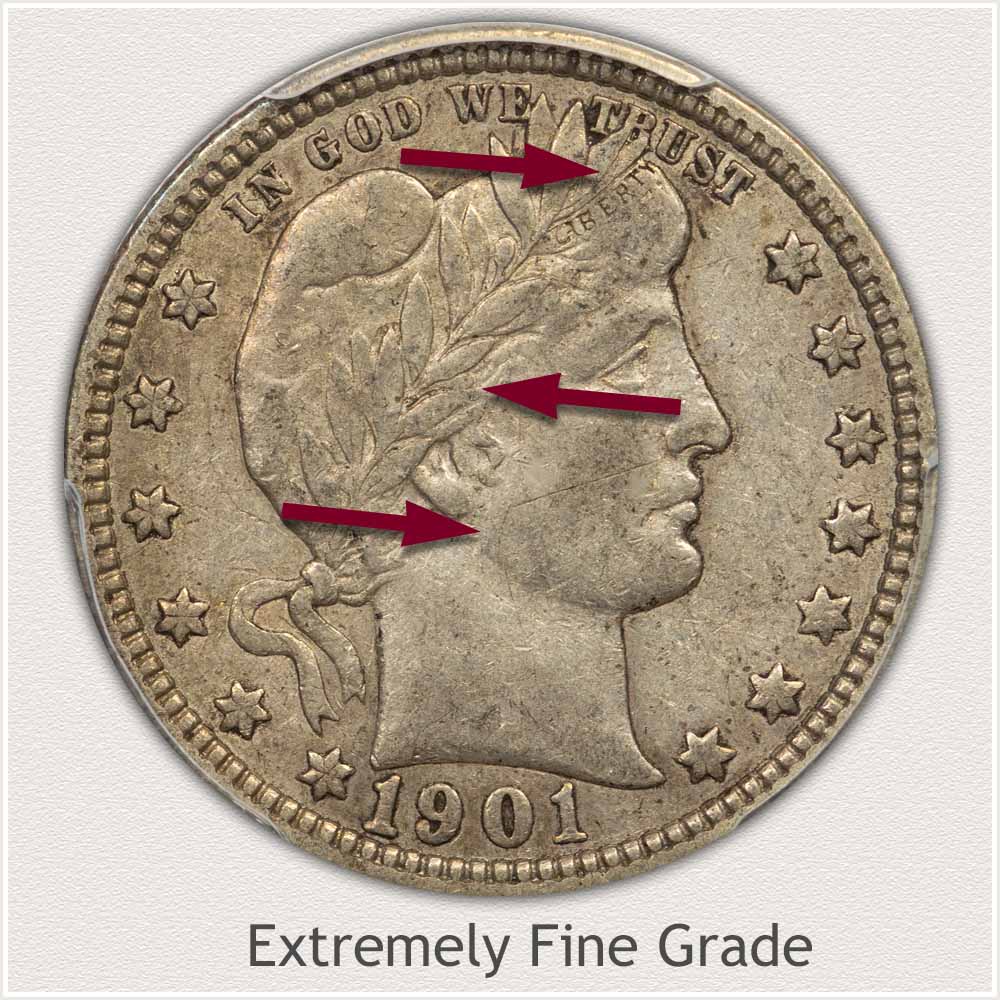
Extremely Fine: An Extremely Fine condition quarter represents collectible quality. All design elements remain with only small touches of wear on high relief points. Very light wear helps to define the condition of the coin.
Examine the leaves of the wreath within Liberty's hair in order to determine the degree of wear. The lower row of the wreath includes five laurel leaves. All edges of the leaves are separate and distinct from her hair. It is important to confirm this detail. Additionally, LIBERTY inscribed in the band over her forehead is clear with all lettering bold. Design elements of the band have an upper and lower border; those with clear borders are high quality for the grade.
Overall features, cheeks, and neck of Liberty are only slightly worn, and the high facial contours are barely flattened. When viewing an Extremely Fine grade quarter, noticeable is the look of crisp details.
Fine Grade
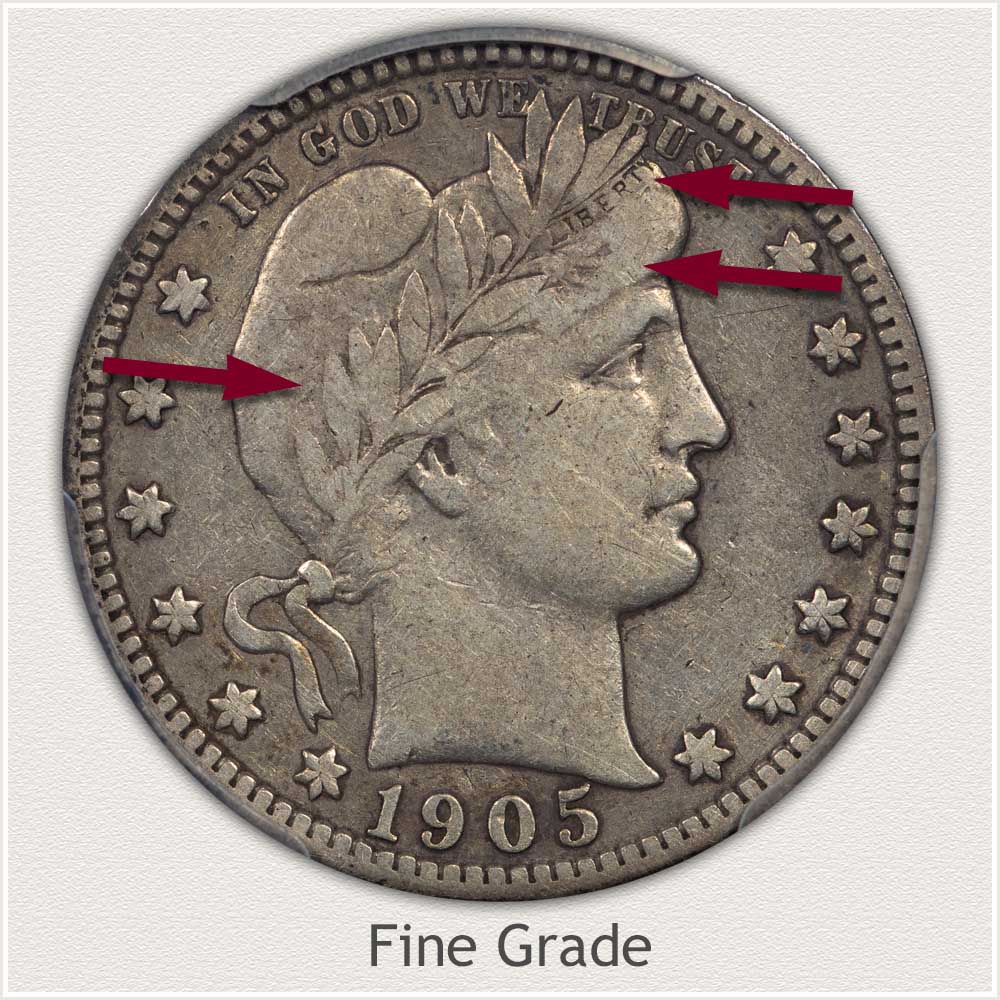
Fine Grade: Fine condition Barber quarters are collectible quality coins. In order to identify key details, a close look is taken at a couple of important design elements. The Fine grade is defined by moderate wear overall.
Time in circulation lowers the design's high points by wearing away the depth of these details. Hair atop Liberty's forehead is one of the highest points on the coin. When the fine strands of hair have lost their details, the coin is classified as Fine grade. Also, the line at the bottom of the headband is missing and has become blended with her hair.
Condition of the leaves within the wreath is another feature of the grade. All that remains of each leaf is a flat, smooth surface. There is no visible interior leaf detail. The upper row of leaves' edges are visible in order to maintain the grade. There is some subtle blending in places where the leaves touch, with the majority of leaves still clearly distinguishable.
Many finer elements of design is still present, giving the overall impression of quality.
Good Grade
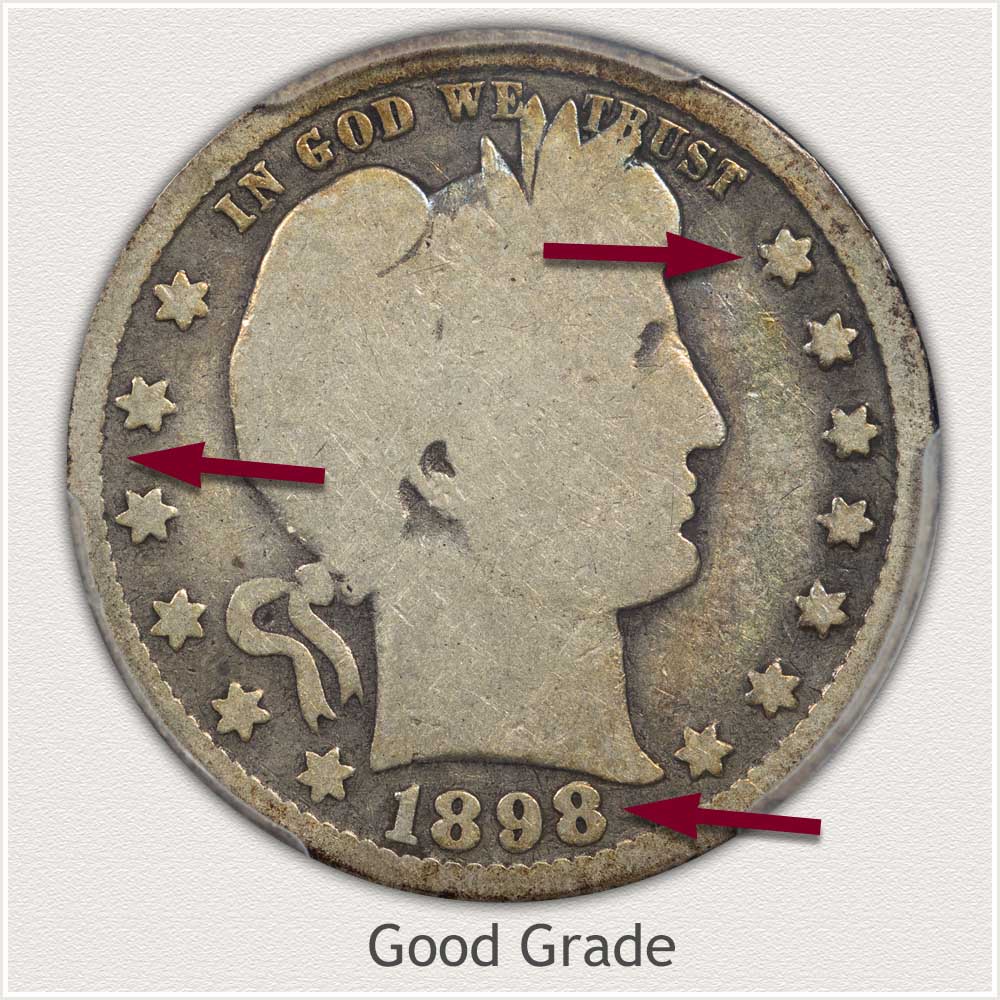
Good Grade: All major design features are worn smooth but remain bold of the fields, defines the condition of a quarter in Good grade.
Starting with the date, all numerals are crisp and full. No merging with the rim is fading their boldness. Moving to the rim itself, it is well worn, a fraction of its original height above the field. Inspecting the inner edge, shows it remains complete around the entire coin.
The stars of the design are all complete. These stars and the lettering of the motto remain well raised, adding a crisp "look" to the overall coin. This example has avoided receiving any large marks and is a nice old quarter.
How to Video: Grading Barber Quarters
The video reviews subtle points of interest related to grading. Judge the condition of the coin following the images and inspect important features closely.
Video, Images and Descriptions | Grading Barber Quarters
Step 3: | Special Qualities and Strong Collector Interest
Fame of the San Francisco Mint Variety 1901 Quarter
1901 is a well-known year of the Barber quarters series. Within the year, the San Francisco mint struck what became the key issue of the entire Barber quarter series. Collectors are keen to correctly identify the mint variety of 1901 quarters. These quarters are now considered the rarest collectible date and mint combination of all Barber quarters.
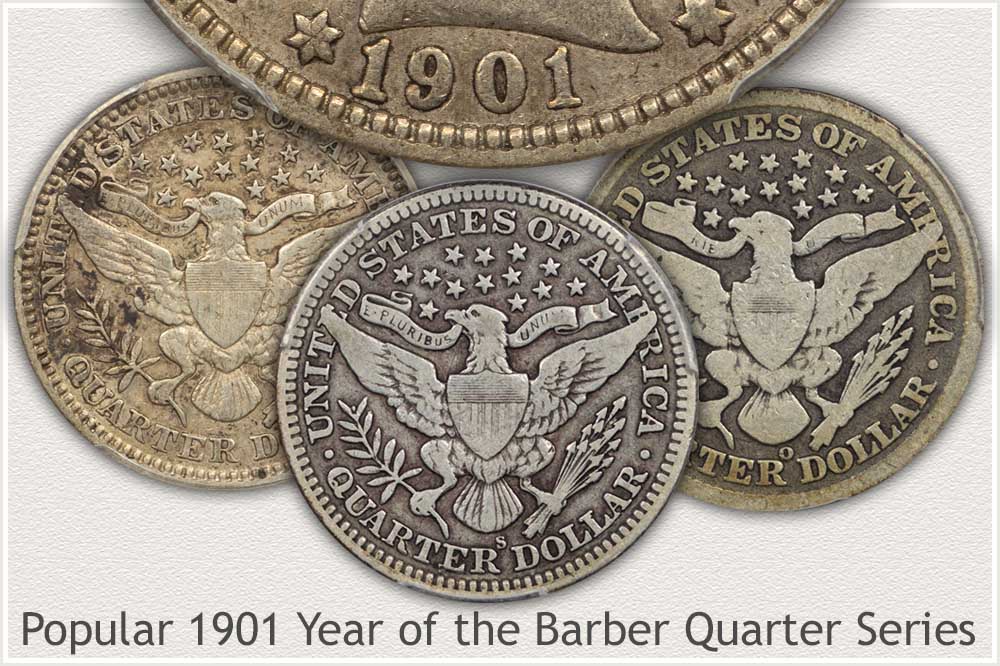
San Francisco struck just 72,644 quarters dated 1901. The collecting community has recognized the difficulty obtaining an example - in any condition. Demand plus small remaining numbers provides a very strong value base to any 1901-S quarter.
Adding to the demand for all 1901 quarters is the popular New Orleans mint variety. These coins enjoy both demand as part of a date and mint set and as part of specialty collections of New Orleans coinage.
Philadelphia, the third mint issue of 1901 quarters, is the available variety. New collectors find them appealing as additions to date collections. An excellent choice to represent a 1901 Barber quarter.
Fame of the 1901 San Francisco quarter extends to the New Orleans and Philadelphia varieties, adding a special quality to each. Standout years in a coin series draws attention to all varieties.
A large appeal of Barber quarters and a special quality is the ability of all levels of collectors to participate. Despite the many scarce varieties and extreme rarities, completable collections are possible. At least one variety of each year is affordable. As collectors grow and expand with experience, collections become more complex as they add the scarce varieties. These quarter have a wide collector base to value.
References
U.S. Mint. 1902 U.S. Mint Annual Report.
https://nnp.wustl.edu/library/book/321
U.S. Mint. Catalogue of Coins of the United States.
https://nnp.wustl.edu/library/book/554591
Coin Values | CoinStudy Articles
Date by Date
In Depth Barber Quarter Values
1892 to 1916
Barber Quarter Value | Many In Demand Dates
Different condition coins are valued separately, also the many dates and mints of the Barber quarters range from common to scarce to very rare. Complete value chart of all dates and mints with condition ranges are listed. All dates of the series are in demand.
Old Coin Values | Step by Step
Determining the value of a few coins or complete collections follows a similar process. Important factors are recorded, including series, date and mint combinations. Barber quarters are listed and organizes alongside, but separate of other series. Steps are taken in specific order to assure a compete judgement of value.
Rare Quarters | Spanning the Many Series
Many Barber quarters are entering the scarce to rare value range. Those of the 1890's are difficult to find in nice condition. All series of quarters are reviewed, pointing to the scarce and rare qualities placing these old coins high in value.
Barber quarters of the available issues in heavily worn grades have a strong value based on their silver content. Using images, identify U.S. silver coinage, calculate current worth, and reference dealer listings to find buyers of these silver coins.
Coin Grading Services | Authenticate and Grade of Coins
High value coins are routinely sent to a grading service to authenticate and grade the piece. The two leaders in coin grading are NGC and PCGS. Each provide assurance of condition and grade of coins helping narrow the value range. Market acceptance of condition is often worth the fee to review the coin.
★Coin Values Discovery finds 1901 Quarter Value and...
All old U.S. coin values. The home page Introduces the important steps in the value process. Identifying your coin series, accurate date and mint, and images to compare when judging condition. Key elements are noted to narrow a range of how much these old coins are worth.
